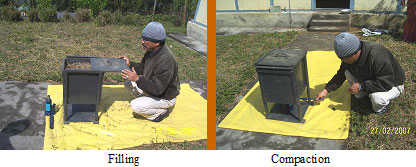Method
- Crop residues / washed and dried fodder resides refused by animals are chaffed to 4 – 5 cm in length or less.
- Ingredients taken (g/kg):
Crop by-product / dried forage residue – 740
Crushed maize - 100
Mustard cake - 100
Bentonite - 50
Mineral mixture - 6
Common salt - 4
- Mixed
- Suitable quantity (4 – 5 kg) of feed mixture is taken.
- Moistened with water and fed into the machine
- Compressed by hydraulic jack.
- Dried in the sun
- Stored until it is fed to the animals



User-friendly Small Scale Silage Making
- Silage is a preserved feed prepared from green forage that is fermented in absence of air and fed to cattle, buffalo, sheep, etc.
- Silage can be made in the NEH Region during rainy season when the forage is abundant. It can be used during winter season when feed scarcity is very high.
- In general silage making does not get popularity to small and marginal farmers because of high capital investment to construct silo-pits.
- However, the method described here is cheaper and user – friendly.
Materials required
- Chaff cutter, high-density polythene bag, rope, green grasses, tree leaves, crushed maize, crop residues like maize stover, millet stover, pulse straw, etc.
Ensiling Method
- Green forage chopped into small pieces with chaff cutter of about 4 – 5 cm length is mixed with 3% crushed maize.
- High moisture content forages such as jungle grasses, tree leaves should be mixed with low moisture content forages like crop residues, maize stover, millet stover, cowpea, pulse straw, etc.
- The well-mixed materials are then filled into high-density polythene bags layer-by-layer, trampled by foot or any wooden thick stick to release air in between.
- After complete filling the mouth of the bag is tied with rope and kept inverted on the ground.
- Whole operation of harvesting of crop, chaffing, filling and sealing of bags, etc should be completed as early as possible on the same day.
- Ensure the bag should not be torn off during filling or storage period.
- Silage will be ready to feed the animals after 2-3 months.
Advantages of ensiling
- As haymaking is difficult in North Eastern Hilly Region, silage making is an alternate method to preserve the excess forage biomass available, for use in the lean season (winter).
- Ensure supply of feed during lean season.
- Ensure a consistent level of production throughout the year.
- Green forage can be stored for a long period (12-18 months).
- Thick stems of mature forages become soft, more palatable and better utilized.
- Acids produced during ensiling are easily utilized as a source of energy by the animals.
Many undesirable worms and their eggs present in the fresh crop are eliminated after ensiling


